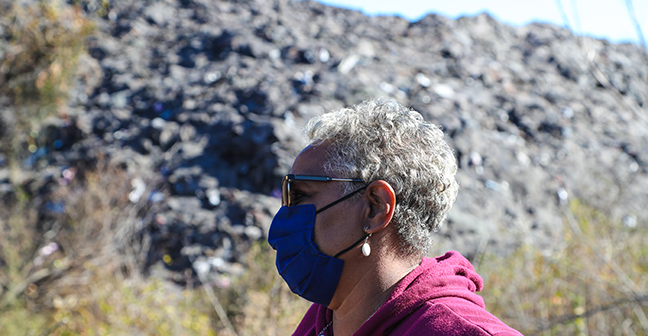environmental SCIENTIST | Seeking Natural Justice | September 2023
Marsha Jackson recounts her fight for environmental justice for her community and proves that grassroots activism can bring about change.
In the heart of the US city of Dallas, Texas, a story of resilience, activism and environmental justice unfolded within the community of Floral Farms. Along with a community of steadfast justice advocates, I spent five years as an activist leader fighting against a toxic waste dump and racist zoning policies on a journey traversing the landscape of adversity, systematic neglect and the transformative power of grassroots movement. My path intertwined with an ominous presence known as Shingle Mountain, a towering mound of roofing shingles symbolising not only environmental blight but also a rallying point of change and the emergence of a movement that demanded justice, accountability and a healthier, more equitable future. Beyond the shingles and pollutants, I continue to fight for equity, justice and the power of collective action.
The emergence of Shingle Mountain
My story is deeply intertwined with the community of Floral Farms, a predominantly Black and Brown neighbourhood in Dallas. My community’s experiences have laid bare the intricate web of neglect, health hazards and unequal treatment that marginalised groups often face when dealing with environmental crises, and how our action can evolve into a beacon of hope for other communities fighting against the insidious impacts of environmental racism.1
|
|
| Marsha Jackson in front of Shingle Mountain. © Beatrice McBride on behalf of Denton Black Film Festival |
The tranquillity of the Floral Farms neighbourhood was interrupted in January 2018 when Blue Star Recycling, a company specialising in wood pallet recycling, set up a business there. Initially, the company’s intentions seemed innocuous. Ostensibly, shingles were being received for grinding and reselling to fill road potholes, but they were never resold. Within weeks the landscape was transformed dramatically: the company began stockpiling roofing shingles just 100 feet (30 m) from my bedroom, forming what would come to be known as Shingle Mountain.
The presence of Shingle Mountain was more than an eyesore. It became a pressing health hazard for my family and my neighbours, surpassing the height of some Floral Farms homes. The magnitude of the accumulation was staggering, exceeding 180,000 tons of shingle waste within a matter of weeks, with dumping occurring from as early as 5 a.m. to as late as 9 p.m.2 Air quality rapidly deteriorated as the neighbourhood was filled with noxious fumes. Residents suffered from a putrid odour, while airborne pollutants including dust and fibreglass caused skin and throat irritation and even breathing difficulties.
Recognising the threat posed to my community’s health, I decided to act and reported the issue to the City of Dallas through its 311 service, seeking assistance and intervention. However, calls for help went unanswered. Service requests were closed without any meaningful action, leaving us frustrated and vulnerable. Despite this lack of response from city officials, community determination only became stronger. I reached out to my city council representative in the hope of finding a resolution, only to find that all attempts to engage with local government proved futile. Shingle Mountain persisted, casting a long shadow over Floral Farms and its residents. It was only when a journalist, Robert Wilonsky, covered the story in the Dallas Morning News that the city finally acknowledged the problem, highlighting a disturbing pattern of unequal response to environmental issues based on the community’s socio-economic status.3
Marginalised groups and racist zoning
The violations committed by the recycling company included having no certificate of occupancy, no special use permit and no dust-prevention measures in place.
Special use permits relate to zoning. Economic zoning has existed in the USA since 1926 and continues to shape land use. Land is divided into residential, commercial, industrial and agricultural categories, among others, and these classifications determine what can be built where and where waste can be deposited. Although economic zoning replaced outright racial zoning, little changed in the division and legacy under the ‘new’ rules, meaning this policy amounts to de facto racial segregation and discrimination.4 Race is the biggest factor determining who lives near hazardous waste sites across the country, and polluting industries are often located in communities of colour.5,6 No waste company or concrete batching plant would be – or is – placed near more affluent residents. It is common, however, for authorities to allow this to occur in Black and Brown communities, and my organisation is advocating against any other high-polluting businesses being placed in communities near residents, schools and churches.
We had to educate the City of Dallas that even though the recycling company’s business property was zoned as industrial research and industrial manufacturing, heavy industry is not to be placed near residential areas. My property is zoned as agricultural, which calls for a special use permit for such companies, for which there was none. The inspector acknowledged the permit violations committed by Blue Star Recycling but was powerless to do anything meaningful because the city council did not take enforcement action on such infringements at the time.
Environmental and health impacts
The community faced an uphill battle against the health and quality-of-life ramifications posed by the massive accumulation of roofing shingles. The environmental and social impacts were evident. The sheer scale of Shingle Mountain’s existence was, in and of itself, a visual representation of the City of Dallas’s disregard for the environment and wellbeing of residents. The mounds of shingles dominated the landscape and posed a direct threat to the local ecosystem. The disruption had severe consequences, leading to loss of life, property damage, land value reduction and impact on wildlife. A local child was hospitalised due to the airborne particles affecting their asthma, and in September 2018, the neighbourhood flooded during heavy rain because the creek was filled with shingles and debris blocking its flow; neighbours lost two horses during the flood.
However, the most immediate and personal impacts were felt by Floral Farms’ residents. The pungent odour emanating from the shingles was a constant reminder of the pollutants permeating the air. Airborne contaminants, including fibreglass particles, coated the neighbourhood, which led to a range of health issues: residents reported skin irritation, persistent coughing and worsened respiratory conditions. For those struggling with asthma, the situation was particularly bad. The polluted air forced my granddaughter and me to remain indoors and sacrifice our quality of life and sense of normalcy.
Community collaboration and advocacy
In the face of such dire circumstances, the Floral Farms community rallied together. Community mobilisation and advocacy emerged as powerful tools to counter the seemingly insurmountable challenges we faced. My unwavering dedication ignited a spark that resonated with my neighbours, which inspired them to join forces.7 As the situation became more widely known, residents started sharing their own stories of suffering and adversity caused by Shingle Mountain’s presence. Such a collective grassroots approach to change the situation transformed isolated struggles into a united front against environmental injustice, at a time when following the city’s protocols had seen no result. The community’s shared pain became the driving force behind a collective determination to effect change.
The advocacy efforts became a priority as residents organised meetings, town halls and protests to demand action from the local authorities. My ability to communicate the urgency of the situation and articulate the environmental and health impacts garnered attention beyond the community to reach media outlets and public figures, resonating with allies from different backgrounds who recognised the significance of fighting for the most vulnerable members of society.
My path converged with those of like-minded advocates, which included Temeckia Derrough and Jim Schermbeck. Derrough is an environmental activist in the Dallas neighbourhood of Joppa and founder of the Joppa Freedman’s Town Association. Schermbeck is director of Downwinders at Risk, an environmental organisation aiming to reduce particulate matter pollution. Schermbeck wrote numerous bulletins regarding the particulate matter of Shingle Mountain, and Downwinders at Risk placed air monitors on surrounding properties with the results reviewed by scientists. Their combined efforts amplified the community’s voice, calling people to campaigning action, raising awareness about Shingle Mountain’s repercussions and the broader issue of environmental injustice. Documentaries, news articles and media coverage illuminated the intersection between racial inequality, environmental health and the critical importance of community-led activism.
Legal battles and ongoing challenges
The pursuit of justice was marked by various legal challenges, with court battles between Blue Star Recycling and property owners. Regardless of court orders and contempt charges, the clean-up process faced persistent delays and evasion. The tangled web of legal jurisdiction, bankruptcy filings and regulatory intricacies underscored the uphill battle faced by the communities that demanded environmental justice in the face of systemic challenges.
The removal of Shingle Mountain
The turning point came when the City of Dallas reached a settlement with CCRA, the landowner of Shingle Mountain. It led to the long-awaited cleanup that began in December 2020. The removal of Shingle Mountain was a monumental victory, but the fight was far from over. After its full removal by February 2021, the underlying soil was found to be polluted with lead. The city council initially said the lead was present prior to Shingle Mountain, but later funded the remediation of the property and removal of 40,000 cubic tons of contaminated soil at a cost of US$2.5 million. This soil is shortly due to be remediated to meet residential standards. Lingering health risks necessitate ongoing monitoring and remediation efforts to ensure the community’s safety, and monitors will be assessing air pollution levels around the property during remediation.
Community resilience and future hopes
Despite the hardships endured, the dedication and unity of the Floral Farms community serves as a clear testament to the resilience required to combat environmental injustices. I envision a future where the former Shingle Mountain site is transformed into a park – a motion that Southern Sector Rising (my grassroots, BIPOC-led organisation) is advocating for as a form of environmental reparation, uplifting Black, Brown and Latinx cultures and setting a precedent for equitable neighbourhood-led planning across Dallas.8 It is not only healing the land but symbolises the strength of the community’s resolve and of positive change.
Conclusion
My evolution from concerned community member to unyielding advocate exemplifies the potential for individual action to drive systemic change. My story clearly shows the urgent need for equitable environmental policies, proactive community engagement, and amplification of marginalised voices to address environmental injustices effectively. My enduring fight for justice stands as an inspiration for communities worldwide, encouraging them to stand up against injustice and work towards a sustainable and just future.
Marsha Jackson is an environmental activist and community leader who spearheaded the successful campaign for the removal of Shingle Mountain, a hazardous waste site that posed severe risks to her Dallas neighbourhood. Her dedication to environmental justice and community advocacy has brought about positive change and inspired others to stand up against environmental injustice.
Since this article was originally published the remediation of the contaminated soil under Shingle Mountain has been completed. Read more
References
- Mayo, E. (2022) How an Environmental Crisis Catalyzed Community-led Planning to Address Racial Inequities: A Case Study of Shingle Mountain, in Southern Dallas. PLAN 5397. University of Texas Arlington College of Architecture, Planning and Public Affairs. https://rc.library.uta.edu/uta-ir/handle/10106/30344 (Accessed: 7 September 2023).
- Perez Vela, J. (2022) Supporting Environmental Justice: Transformative Leadership Dynamics of Residents in Informal subdivisions. BSc thesis. University of Texas at Arlington. https://rc.library.uta.edu/uta-ir/handle/10106/31156 (Accessed: 7 September 2023).
- Wilonsky, R. (2018) ‘It’s unacceptable’: Why a Dallas woman lives next to mountains of ground-up shingles, Dallas Morning News, 13 December. https://www.dallasnews.com/opinion/commentary/2018/12/13/it-s-unacceptab... (Accessed: 9 September 2023).
- Holtzapple, C. (2021) How economic zoning promotes environmental racism.
- https://theleaflet.org/home-1/how-economic-zoning-promotes-environmental... (Accessed: 9 September 2023).
- Schlanger, Z. (2017) Race is the biggest indicator in the US of whether you live near toxic waste. https://qz.com/939612/race-is-the-biggest-indicator-in-the-us-of-whether... (Accessed: 9 September 2023).
- Whittemore, A.H. (2017) Racial and class bias in zoning: rezonings involving heavy commercial and industrial land use in Durham (NC), 1945–2014. Journal of the American Planning Association, 83 (3), pp. 235–248. https://www.tandfonline.com/doi/full/10.1080/01944363.2017.1320949 (Accessed: 9 September 2023).
- Ahmed, A. (2020) Marsha Jackson is trying to move Shingle Mountain, Texas Observer, 25 August. https://www.texasobserver.org/shingle-mountain-dallas-marsha-jackson/ (Accessed: 7 September 2023).
- Martin, A. (2022) Residents got rid of Shingle Mountain. Is a park in their future? https://greensourcedfw.org/articles/residents-got-rid-shingle-mountain-p... (Accessed: 7 September 2023).






